The Maasai are a prominent semi-nomadic ethnic group of cattle and sheep farmers inhabiting large parts of northern, central, and southern Kenya and northern Tanzania. While other tribes of the Great Rift Valley area have welcomed many of the accoutrements of modern living, the Maasai have held on to much of their traditional lands and way of life.
During a three-day visit to Kenya’s Maasai Mara National Reserve in May 2022, I visited a Maasai village (kraal) for an introduction to the people and their culture. Maasai Mara is an incredible ecosystem that is the northern portion of Tanzania’s Serengeti. At Maasai Mara I enjoyed two amazing vehicle safaris and one balloon safari. A visit with the Maasai provided the opportunity to experience the lifestyle of one group of humans who for thousands of years have managed to thrive in the midst of the dangerous wildlife I saw from the safety of a vehicle or balloon.
Rather than rely solely on my recollection of the information my generous hosts provided, excerpts from Maasai Mara Travel provide a more reliable context for the photos from the visit.
The Maasai tribe, historically a nomadic people, have traditionally relied on readily available materials and indigenous technology to construct their unusual and interesting housing. The traditional Maasai house was designed for people on the move and thus their houses were very impermanent in nature. The houses are either circular or loaf-shaped, and are made by women. Their villages are enveloped in a circular Enkang (fence) built by the men and this protects their cattle at night from wild animals.
The kraal I visited is located in a Maasai conservancy bordering the reserve. It was a short drive from my accommodation, AA Mara Safari Lodge. The son of the village leader and two others met my guide and myself outside the krall.

There are over fifty tribes of native people originally from Kenya. The Maasai are one of the few tribes that have managed to stick to most of their traditions and keep their culture alive. This didn’t come easy though. According to Maasai history the Maasai tribe is originally from north-west Kenya, north of Lake Turkana in the lower Nile Valley. Later on, they migrated south and settled in the Great Rift Valley and the Dodoma and Mount Marsabit region. They were feared for raiding cattle as far east as the Tanga Coast in Tanzania. These proficient warriors excelled in the use of shields and spears but were especially feared for throwing their clubs known as ‘orinka’. Maasai warriors were known to be able to throw the orinka with expert precision across a distance of up to 100 metres.


The Maasai tribe, historically a nomadic people, have traditionally relied on readily available materials and indigenous technology to construct their unusual and interesting housing. The traditional Maasai house was designed for people on the move and thus their houses were very impermanent in nature. The houses are either circular or loaf-shaped, and are made by women. Their villages are enveloped in a circular Enkang (fence) built by the men and this protects their cattle at night from wild animals.


Traditional Maasai people’s lifestyle concentrates on their cattle which make up the primary source of food. Amongst the Maasai the measure of a man’s wealth is in terms of children and cattle. So the more the better. They believe that a man who has plenty of cattle but not many children is considered to be poor and vice versa. A Maasai myth says that God afforded them all the cattle on earth, resulting in the belief that rustling from other tribes is a matter of claiming what is rightfully theirs, a practice that has now become much less common.
I was invited inside one of the homes. Each small, loaf-shaped home consists of three rooms, a kitchen/dinning/sitting area and two bedrooms. In keeping with tradition, there is no electricity. It is dark inside even during the day because windows are small as a precaution against wildlife intrusions.

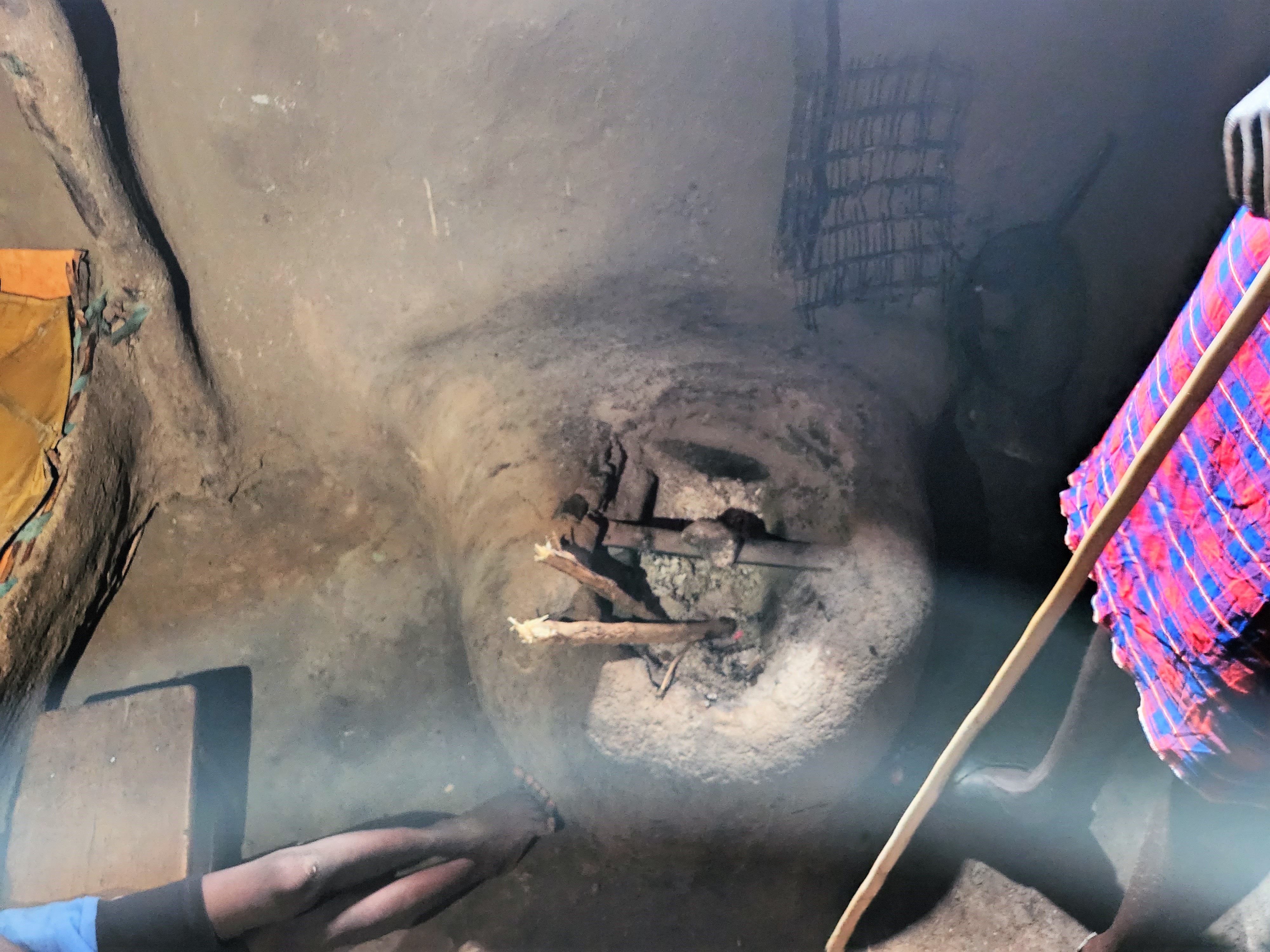
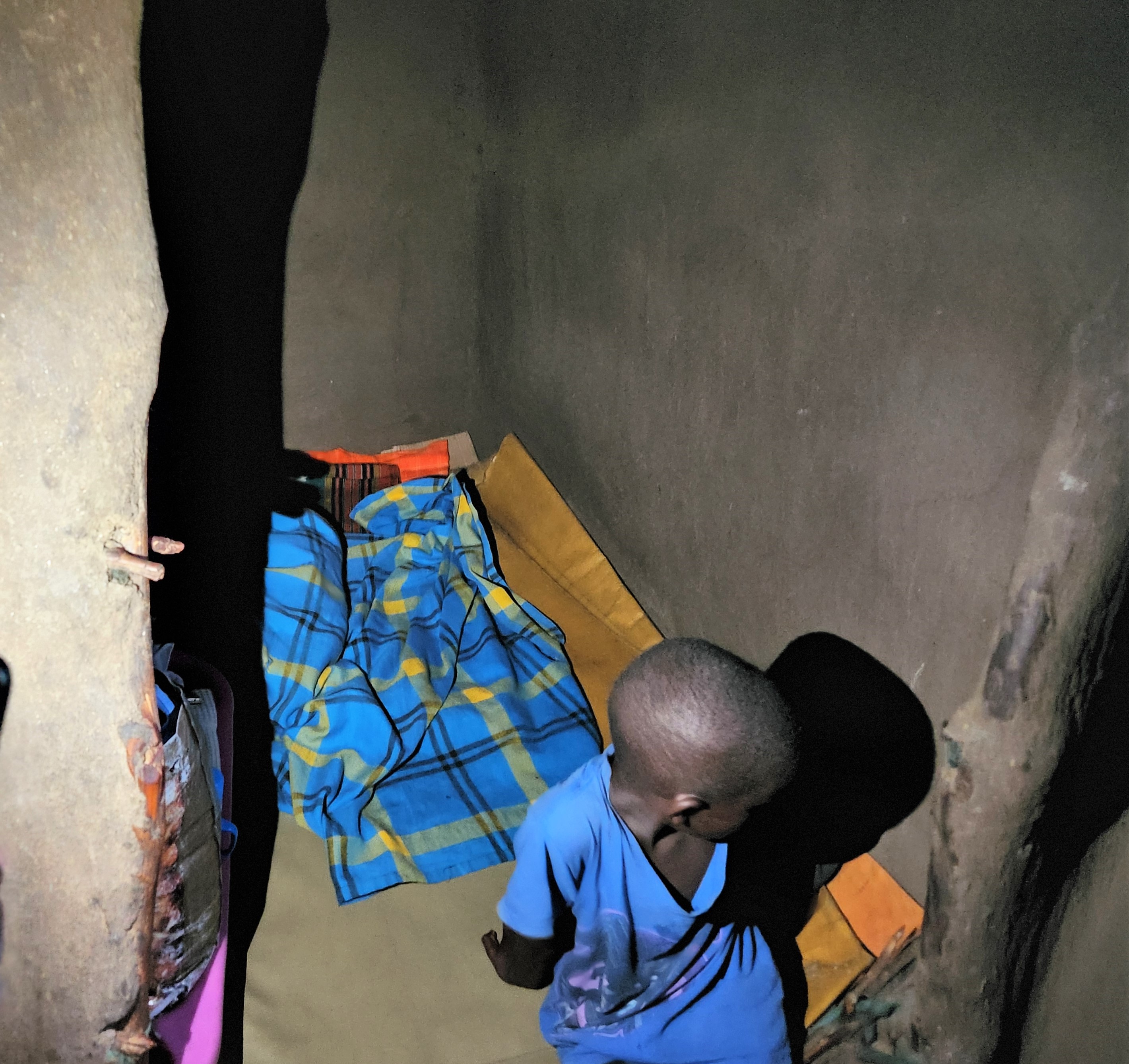
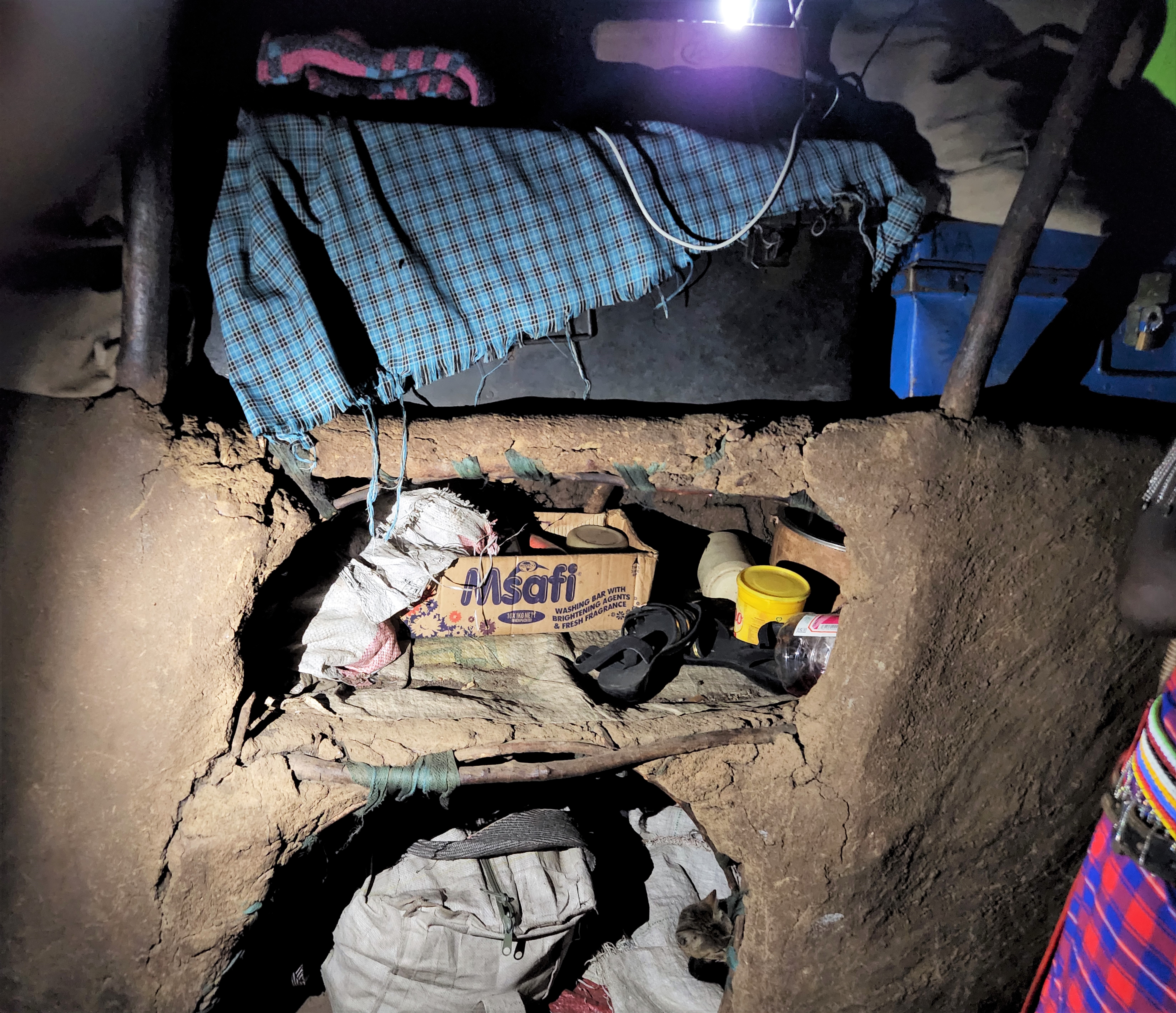
The Maasai have a very patriarchal society. Masai men and elders make all of the important decisions for Masai tribes. They measure a man’s wealth in terms of the number of children a man has and heads of cattle. The more the better. Their diets traditionally consist of the raw meat and milk of their cattle (and at times also of the blood in times of drought). The hides are used to make furniture and the bones are used to create tools. The Maasai clothe themselves in colour swatches of cloth known as ‘Shúkà’. The Maasai have a very colourful culture of music and dance. The women are known to recite lullabies, hum and sing songs of praise about their sons. There’s always one song leader, known as an olaranyani, who leads the group in song.
After the home tour, we went outside for a demonstration of the way the Maasai make fire. This was the part I wanted most to see. The process is surprisingly fast and easy. Maasai start with a notched piece of wood, a small stick that fits into the notch, tinder and kindling.

They roll the stick rapidly between their palms for several seconds until the tinder in the notch glows. The glowing tinder is carefully placed in a bundle of tiny, easily combustible twigs. The firemaker blows on the ember until a flame erupts.

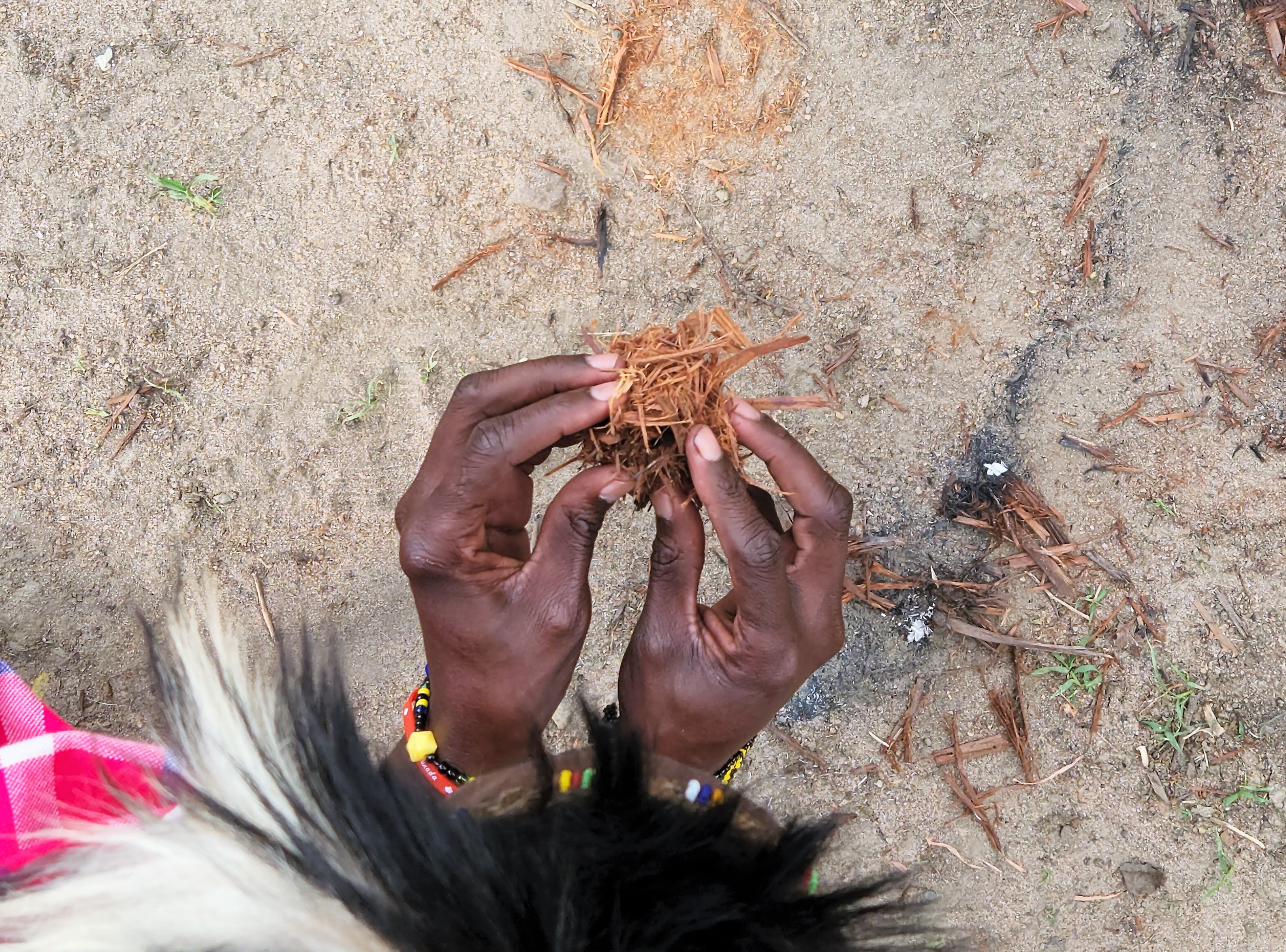

Even though my hands were unfamiliar with the motion, I was able to get a fire going without much difficulty. Using the right materials is crucial. Unfortunately, I don’t remember the names of the materials used for the tinder and twigs.

Clothing varies by sex, age and place. Young men wear black for several months after their circumcision. Although, red is a favored color among the Maasai. Black, Blue, checked and striped cloth are also worn, together with multi-coloured African garments. In the 1960s the Maasai began to replace sheepskin, calf hides and animal skin for more commercial material. The cloth used to wrap around the body is the called Shúkà in the Maa language. The Maasai women regularly weave and bead jewellery, which plays an essential part in the ornamentation of their body. Ear piercing and the stretching of earlobes are also part of Maasai beauty, and both men and women wear metal hoops on their stretched earlobes.

Young Maasai men go through a ceremony that marks their passage to adulthood.
The Maasai traditionally hold ‘coming of age’ ceremonies during which the horn of the Greater Kudu is used to summon all of those coming of age, the initiates, to the ceremony. Such ceremonies last ten days or more and involve quite a bit of singing, dancing and flirting. During the ceremony young men will line up and chant towards a line of singing women standing across from them. A very unique and interesting sight to see. Some parts of Maasai tradition have changed in recent years. Until recently, the single-handed slaying of a lion with a spear was a requirement for all boys who wanted to become Masai warriors.
The lions appreciate the change in tradition as the Maasai population is now about one million. Despite my age, the hosts had me participate in a mock ceremony.
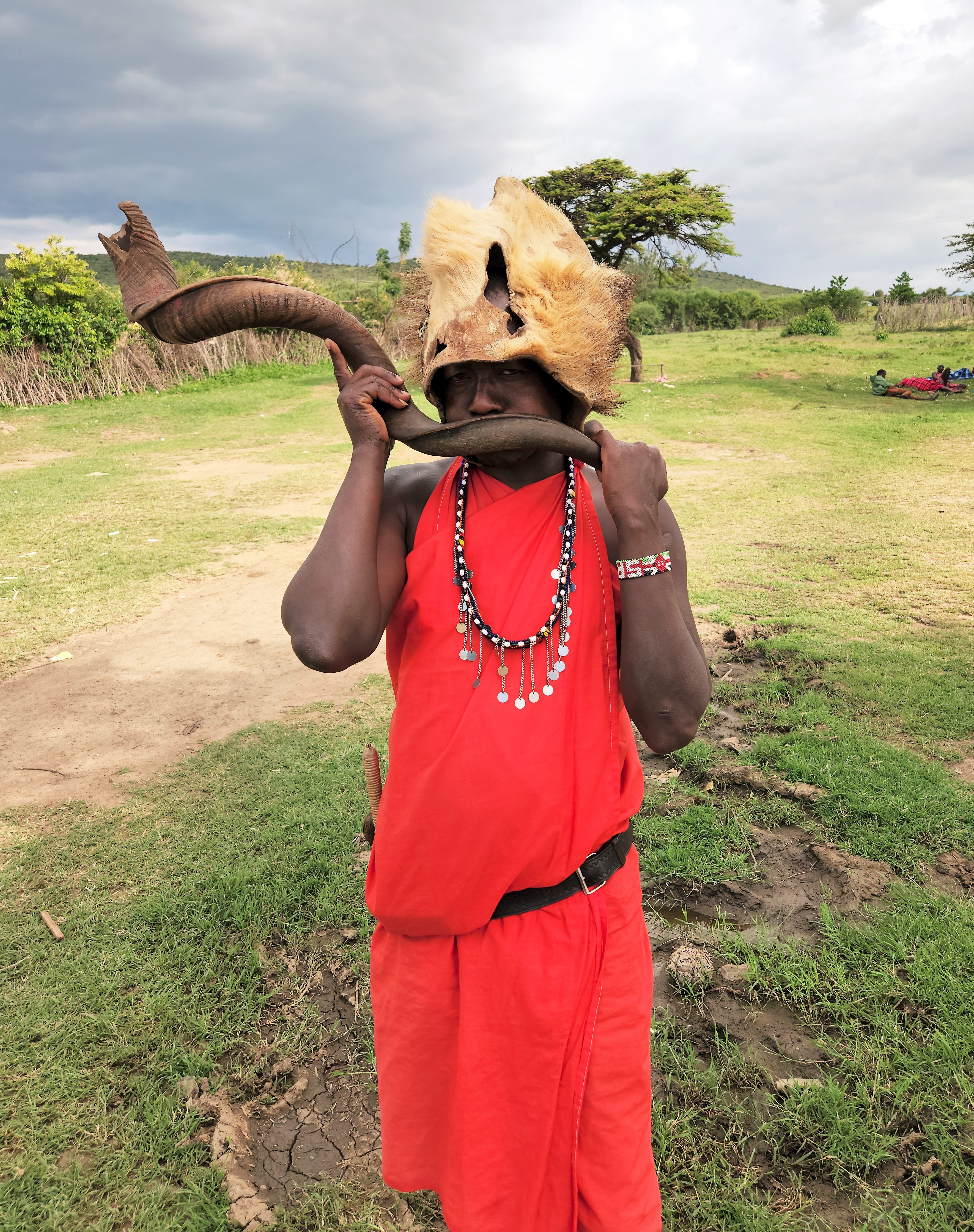

In sixth grade I read Treks Across the Veldt by Theodore Waldeck. I don’t remember the story except that it sparked a recurring dream of walking across the African savannah with just a spear and a big dog. The ceremony and lion head hat made me recall that childhood dream.
The Maasai people don’t use instruments when they are singing or dancing. All of their music is vocal, except for the large horns used for certain songs. Their music comprises of rhythms rendered by a chorus of vocalists singing harmonies, all the while the olaranyani (song leader) sings the melody. The olaranyani is usually the person who can best sing that song. When olaranyani starts singing a line or title (namba) of a song, the group responds with one unanimous call in acknowledgment. The beads that both the men and women wear also create a jingling sound themselves while the Masai jump and dance.
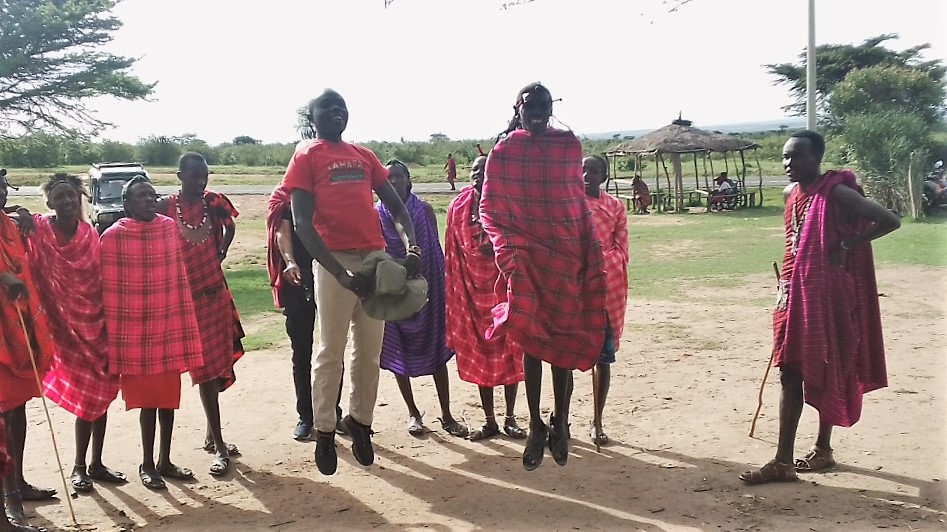
This video shows Maasai singing a traditional song and performing a jumping dance.
Maasai understand the concept of marketing as the last item on the agenda was perusing a selection of jewelry and artifacts handmade by Maasai craftsmen. Bargaining was involved, and I’m sure I overpaid for a few souvenirs. I didn’t mind since I’m uncomfortable bargaining when I have no idea of the real value of the products. I looked at the process as a donation. Among other endeavors, Maasai earn income from leasing their land to safari and hotel operators and serving as guides.
Overall Impression
I very much appreciated meeting friendly Maasai warriors and getting a glimpse of the Maasai lifestyle. I applaud them for holding on to their traditional culture. Thanks for visiting. Please enjoy your weekend.

A great article, thank-you. As a child I was lucky enough to get into the homes of Maasai, right out in the rural areas. Its interesting to see how the homestead design has changed, and how bright colourful kangas are worn nowadays.
LikeLiked by 1 person
The Masaai are an amazing and admirable people. Thanks for sharing.
LikeLike
looks way cool John, thanks for sharing and sharing a bit about what life there is like. The roofs are awesome still growing grass on them and by the definition of a rich man – I feel very poor!
LikeLike
Very interesting account! I like the way you include the extra information with your photos and own comments and impressions. I learnt a lot!
LikeLiked by 1 person
It is good to know you found the post interesting and informative. I appreciate your taking the time to read and comment.
LikeLike
You were fortunate to have a rare glimpse into a culture that seems to have survived with customs intact. The houses look so sparse, the dance and music joyous. I hope opening their community to tourism has been more positive than invasive.
LikeLiked by 1 person
Maasai have not escaped their encounter with the modern world unaffected. They make money from the conservancies, safaris and tours. So I think they now measure wealth in more than just cattle and children. They are a proud people.
LikeLiked by 1 person
What an amazing experience! Their way of life seems fascinating and I would very much enjoy a visit like this.
LikeLiked by 1 person
For everyone the tough part of enjoying this experience is getting to Kenya. YouTube has many videos on Maasai dance and culture if you’d like to see more.
LikeLiked by 1 person
What great insight and sharing of their incredible culture John. Loved the houses and was taken back by the fact that wild animals wouldn’t enter anyway. While I love color and their beads and horns, I’m surprised that wouldn’t draw animal attention but maybe they only come out at night.
I want those spring hips they have!!!! 🤣😎
The “kids” left last night at 6:30 p.m. and have arrived to their gifts of the trip on their. bed. soooo fun. ❤️
LikeLike
Lions have learned to avoid the colorful Maasai. I’d be most afraid of snakes coming into a home. Now that the wedding is done, maybe you can take a vacation. 🙏😄🧡
LikeLike
Wow, what an incredible experience this must have been, and how lovely of them to be so inviting into their daily lives! I loved watching the video of their jumping dance, and I’m fascinated by just how high they do it!
LikeLiked by 1 person
It was fun to see the village and try my hand at making a fire. I’m happy for the Maasai but also appreciate the conveniences that make life easier if not more complicated. Thanks for visiting Natty! John
LikeLiked by 1 person
Wow, what absolutely stunning photos which capture a way of life unimaginable to us. I love the colours…and I said I liked your hat in Singapore, but this one’s even better 🙂
LikeLiked by 1 person
I’m so glad there weren’t any satellite dishes on their homes. They choose to live as close as feasible to the way they have for thousands of years. I wish them the best with maintaining that lifestyle. It is a cool hat. They said it is a lion’s head. Thanks for checking out the post.
LikeLike
It’s always very insightful to visit the locals in their traditional environment – like the kraal you visited here. It is fascinating to see the fire making process – we have tried this many times when we were children (and sometimes succeeded, but only sometimes 😉). And how lovely are the women’s traditional clothes – so colourful. Goodness, they can jump high … what do you think will happen when they are given a trampoline? Thanks John, a lovely post with great photos!
LikeLiked by 1 person
The Maasai seem to be very comfortable with their decision to shun most of modern technology and rely on their traditions. They have lived with their cattle and other livestock in the midst of the animals I saw on safari. They have managed without exterminating the dangerous wildlife and without safari vehicles that protected us and no guns. I was surprised how easy it was to use the Maasai match. Using the right materials is the key. A trampoline would make the jumping dance a lot easier for sure. 😄
LikeLiked by 1 person
Such a fascinating site we visited. Thanks for sharing this and you really enjoyed this area.
Anita
LikeLiked by 1 person
I’m happy to share. It was fun to see a bit of how the Maasai lived. Have a great evening Anita. John
LikeLiked by 1 person
I love how colorful their clothing is, John. They stand out instead of blending in.
LikeLiked by 1 person
I think predators like lions recognize their clothing and are wary of them.
LikeLiked by 1 person
What a neat experience! I also got a kick out of the “loaf shaped” homes, but it is very fitting.
LikeLiked by 1 person
I don’t even think the Maasai eat bread.😄
LikeLike
What an amazing experience! It’s so fullfilling to meet people, the way they live and their culture when travelling. Thank you so much for sharing, John!
LikeLiked by 1 person
Amazingly, they say very few Maasai ever decide to move to cities or use modern conveniences. I did see motorcycles at the village though. Thanks for dropping by Blanca.
LikeLiked by 1 person
Totally fascinating! I love that you took the time to meet the people on your travels.
LikeLiked by 1 person
It is interesting that Maasai have lived with the dangerous wildlife of the Mara for thousands of years without exterminating them. That story needs more explanation I think. I got a kick out of making fire.😁
LikeLiked by 1 person
We visited a maasai village as well. My biggest memory was the smell of cow dung. ☹ But it is a great opportunity to see how they live. Maggie
LikeLiked by 1 person
It would have been interesting to have seen them drink cattle blood and throw the orinka or rungu, a throwing weapon. As far as I could tell with my awful sense of smell, there was no cow dung smell.
LikeLike
It is always good when you get a glimpse into the local culture and way of life, even if it has been staged for tourist consumption. Understanding that our way of life is not the only way will only help the world. Thanks for sharing John. Have a great Sunday. Allan
LikeLiked by 1 person
It is a glimpse for sure. I have a feeling there is a lot of politics behind the relationship between the Maasai and the reserve and conservancies. Maasai live with the animals of the Mara. I wish there had been more information about that. Have a great day Allan.
LikeLiked by 1 person
I was fascinated by the Maasai and found them very photogenic, partly because of those red robes. We were told that the ‘village’ we visited was when specially set up for sightseeing, so that visitors could see and understand their way of life without intruding on their actual homes. Were you told the same about this one?
LikeLiked by 2 people
Interesting. That is not what I was told on this visit. The home I went in looked like people lived there. It is possible it was a fake though.
LikeLiked by 1 person
Maybe this is different. Also, we visited a long while ago – they may have got more open to visitors now.
LikeLiked by 1 person
The village seemed real but it could have been faked. I didn’t see a lot of people.
LikeLike
That looks like such an interesting and fulfilling trip
LikeLiked by 1 person
Visiting a Maasai village is a must to add to try to understand their coexistence with the wildlife.
LikeLiked by 1 person
Thanks for the summary of your anthropological discoveries during your Kenya trip.
LikeLiked by 1 person
I don’t know how much I learned about the Maasai. Their story is complicated. At least I made fire without a match. 😃
LikeLiked by 1 person
I learned a few aspects about their lives from your blog post, so that’s something.
LikeLiked by 1 person
I appreciate that. I’m glad I shared information that is helpful. Have a great Sunday, Swabby.
LikeLiked by 1 person
Thanks!
LikeLiked by 1 person
What an incredible opportunity and experience, John. Interesting that the women make the houses, would there be a particular reason for that? “Loaf-shaped” is a perfect description of the buildings, though they seem a bit grim inside. Was that your impression, or did you feel they were homey? Love their traditional clothing, very colourful and vibrant.
LikeLiked by 1 person
The homes are grim from my point of view and they are very tiny considering Maasai make it a point to have many kids. Maybe one family has more than one house. Getting a good understanding of their society requires more than a 90-minute tour. At least I got a feel for it I think.
LikeLiked by 2 people
Wow! Amazing experience! Interesting post!
Thank’s for share, John.
Enjoy your weekend!
LikeLiked by 1 person
Much appreciated, Elvira. Have a great evening!
LikeLike